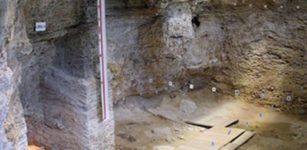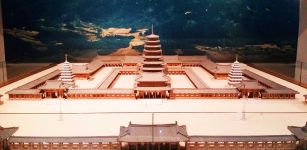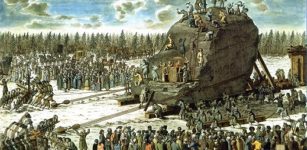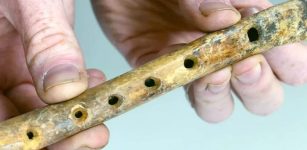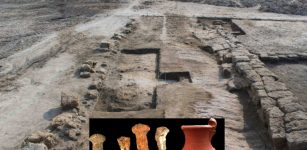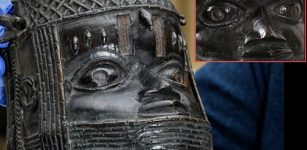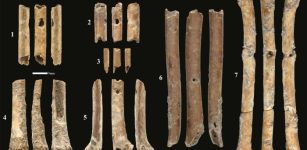Bad King John’s Lost Treasure May Be Hidden Near The Walpole Marsh In The Fenlands – Archaeologists Say
Jan Bartek - AncientPages.com - Archaeologists are making a new attempt to locate King John's legendary lost treasure. This time, they focus their attention on an area of land next to Walpole Marsh in the Fenlands in eastern England.
The tale of King John's lost treasure is not just a myth passed down through the ages. It is rooted in historical facts. John, who ruled England from 1199 to 1216, was a disaster as a monarch. He was involved in plots against his brother when he was away and participated in the Crusades. He ended up on the throne in 1199 after Richard the Lionheart died on the battlefield in France. From then on, he earned himself an unfavorable reputation as 'Bad King John.'
King John is also famous for sealing the Magna Carta, one of the most important Medieval documents.
King John signing the Magna Carta reluctantly by Michael, Arthur C . Credit: Public Domain
'Bad King John' was a jewelry enthusiast. He was especially fond of collecting (stealing) jewelry for himself and coinage for his guards and soldiers. His collection boasted an array of gold and silver plates, among other valuables. The crown jewel was the imperial regalia he inherited from his grandmother, the Empress of Germany.
However, on October 12, 1216, John's treasure trove was lost. The king’s attempt to cross a stretch of water in Wash - a large bay separating East Anglia from Lincolnshire - via a shortcut proved disastrous. This marshy region with its mudflats was typically passable at low tide but posed significant risks otherwise.
Unfortunately for King John, he underestimated the tide's speed that day. The waters rose faster than anticipated, and his miscalculation resulted in his valuable baggage train falling victim to the advancing waves.
Although the King managed to cross the Wash west of Lynn, his party was not as fortunate. Up to 3,000 soldiers and servants, carrying the King’s possessions were swallowed by the rising tide and vanished in the turbulent waters. A whirlpool swallowed all royal treasures reportedly onboard, including the Crown Jewels and gold coins, and the treasure was never found.
King John succumbed to dysentery in Newark on October 18th at just 49 years old.
An archaeological excavation in Norfolk might finally solve the mystery of King John's lost treasure. This wealth, swallowed by the tide around 800 years ago, has remained elusive ever since. The precise location of the disaster is still unknown. One must also not forget that the ground has changed plenty over time. What was once an estuary and salt marsh has been transformed into farmland, burying any potential treasure approximately 5m below the surface.
The most likely location is expected to be somewhere between Walpole Cross Keys and Sutton Bridge, where construction for the new solar farm is about to start soon.
In 2022, developer Enso Green Holdings successfully appealed a planning decision regarding installing panels on 200 acres of farmland at Walpole Marsh. This proposal was initially rejected by West Norfolk Council.
Now, the green power firm's archaeological consultants have prepared plans for an extensive survey of the site. The council has approved this project.
The plan includes digging around 20 trenches in various locations across the site. Geophysical surveys have uncovered evidence of old watercourses from when the area was a tidal marsh.
Clive Bond, chairman of the West Norfolk and King's Lynn Archaeological Society (WNKLAS), said: "It's an opportunity to take a glimpse into the landscape. When you're looking at something this big it's quite exciting.
Sutton Bridge. Credit: Peter Latham - CC BY-SA 2.0
"There could be something there, absolutely, but actually getting to where it's been deposited in a changing, dynamic river system - you're looking a million to one.
"They will find stuff, that's medieval and post-medieval but I suspect the problem here is you'd need an intervention that would go deep."
Previously, scientists have utilized LIDAR (light detection and radar) technology to perform aerial surveys in their quest to uncover the exact path of King John's luggage train. However, this elusive route has remained hidden, even from these advanced sky-high observations.
See also: More Archaeology News
There is a fair amount of skepticism about whether King John's long-lost treasure will actually be discovered this time.
Nothing's ever been found," King's Lynn historian Dr Paul Richards said. "The thing is, he wouldn't have been carrying much treasure as he'd spent most of it on fighting.
"No regalia has ever been found after his death - he probably flogged it to fight the barons, the French, he must have spent a lot of money," Dr. Richards added.
Written by Jan Bartek - AncientPages.com Staff Writer





